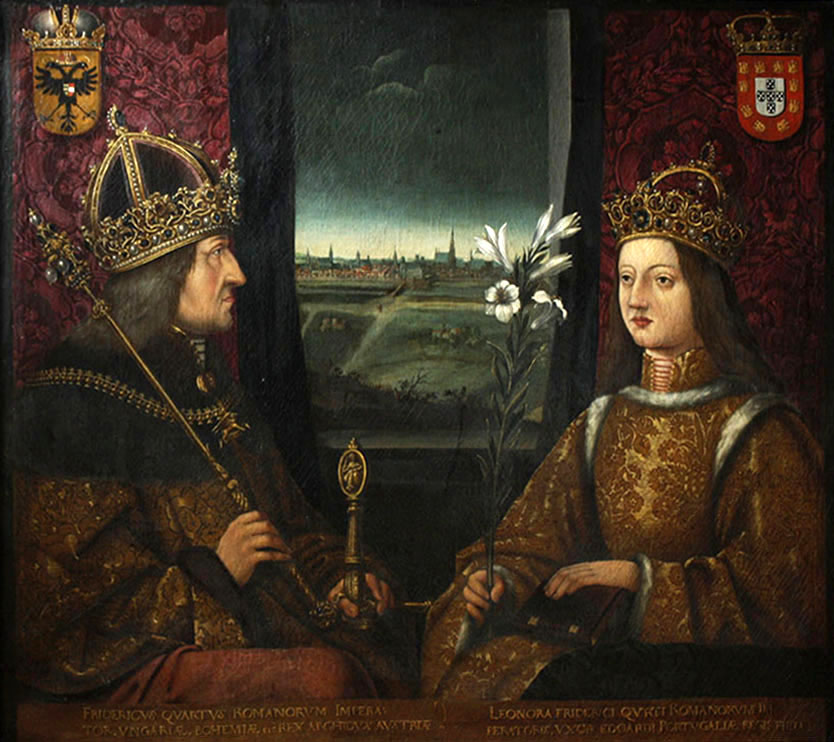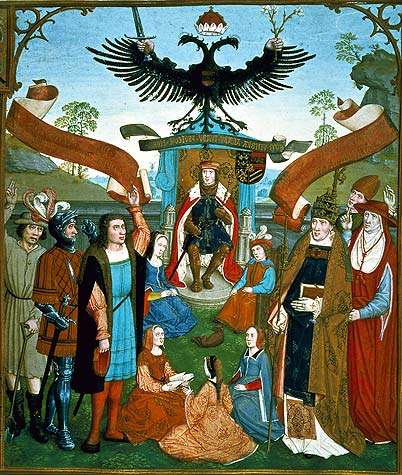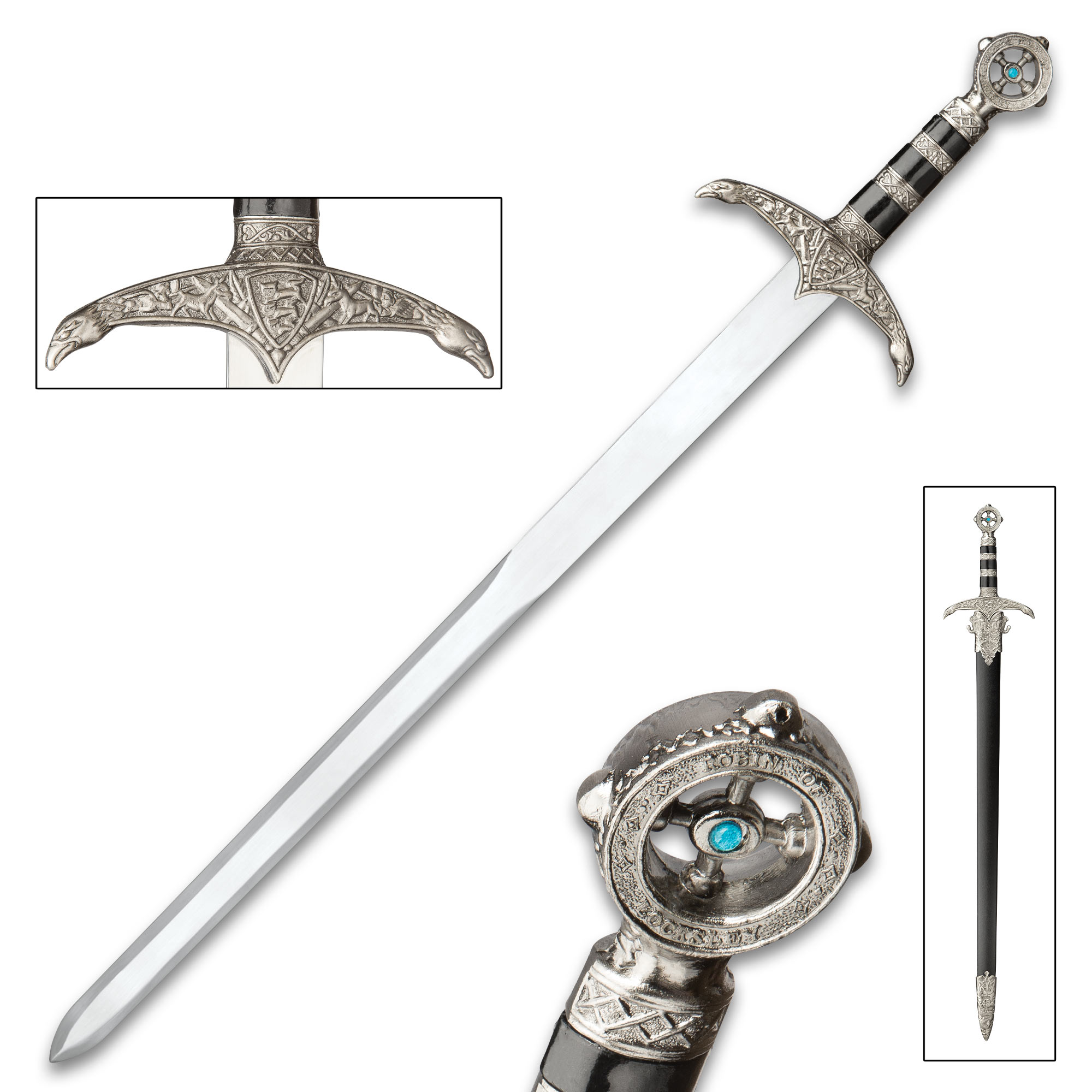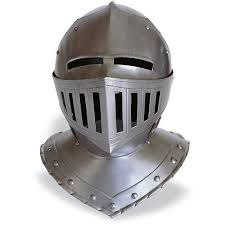

More about Arthur
Who was the last knight, or "Der Letzte Ritter", really? Did he actually exist?

Maximilian I (22 March 1459 – 12 January 1519) was Holy Roman Emperor from 1508 until his death. He was never crowned by the pope, as the journey to Rome was always too risky. He was instead proclaimed emperor elect by Pope Julius II at Trent, thus breaking the long tradition of requiring a papal coronation for the adoption of the imperial title. Maximilian was the son of Frederick III, Holy Roman Emperor, and Eleanor of Portugal. He ruled jointly with his father for the last ten years of the latter's reign, from c. 1483 to his father's death in 1493.
Maximilian expanded the influence of the House of Habsburg through war and his marriage in 1477 to Mary of Burgundy, the heiress to the Duchy of Burgundy, though he also lost the Austrian territories in today's Switzerland to the Swiss Confederacy. Through marriage of his son Philip the Handsome to eventual queen Joanna of Castile in 1498, Maximilian helped to establish the Habsburg dynasty in Spain, which allowed his grandson Charles to hold the thrones of both Castile and Aragon.

Maximilian was born at Wiener Neustadt on 22 March 1459. His father, Frederick III, Holy Roman Emperor, named him for an obscure saint, Maximilian of Tebessa, who Frederick believed had once warned him of imminent peril in a dream. In his infancy, he and his parents were besieged in Vienna by Albert of Austria. One source relates that, during the siege's bleakest days, the young prince would wander about the castle garrison, begging the servants and men-at-arms for bits of bread.[3] The young prince was an excellent hunter, his favorite hobby was the hunting for birds as a horse archer.

At the time, the dukes of Burgundy, a cadet branch of the French royal family, with their sophisticated nobility and court culture, were the rulers of substantial territories on the eastern and northern boundaries of France. The reigning duke, Charles the Bold, was the chief political opponent of Maximilian's father Frederick III. Frederick was concerned about Burgundy's expansive tendencies on the western border of his Holy Roman Empire, and, to forestall military conflict, he attempted to secure the marriage of Charles's only daughter, Mary of Burgundy, to his son Maximilian. After the Siege of Neuss (1474–75), he was successful. The wedding between Maximilian and Mary took place on 19 August 1477.
Maximilian's wife had inherited the large Burgundian domains in France and the Low Countries upon her father's death in the Battle of Nancy on 5 January 1477. Already before his coronation as the King of the Romans in 1486, Maximilian decided to secure this distant and extensive Burgundian inheritance to his family, the House of Habsburg, at all costs.[5] The Duchy of Burgundy was also claimed by the French crown under Salic Law,[6] with Louis XI of France vigorously contesting the Habsburg claim to the Burgundian inheritance by means of military force. Maximilian undertook the defence of his wife's dominions from an attack by Louis XI and defeated the French forces at Guinegate, the modern Enguinegatte, on 7 August 1479.[7] Maximilian and Mary's wedding contract stipulated that their children would succeed them but that the couple could not be each other's heirs. Mary tried to bypass this rule with a promise to transfer territories as a gift in case of her death, but her plans were confounded. After Mary's death in a riding accident on 27 March 1482 near the Wijnendale Castle, Maximilian's aim was now to secure the inheritance to his and Mary's son, Philip the Handsome.
Some of the Netherlander provinces were hostile to Maximilian, and, in 1482, they signed a treaty with Louis XI in Arras that forced Maximilian to give up Franche-Comté and Artois to the French crown.[6] They openly rebelled twice in the period 1482–1492, attempting to regain the autonomy they had enjoined under Mary. Flemish rebels managed to capture Philip and even Maximilian himself, but they were defeated when Frederick III intervened.[8][9] Maximilian continued to govern Mary's remaining inheritance in the name of Philip the Handsome. After the regency ended, Maximilian and Charles VIII of France exchanged these two territories for Burgundy and Picardy in the Treaty of Senlis (1493). Thus a large part of the Netherlands (known as the Seventeen Provinces) stayed in the Habsburg patrimony.
Maximilian was elected King of the Romans on 16 February 1486 in Frankfurt-am-Main at his father's initiative and crowned on 9 April 1486 in Aachen. He became ruler of the Holy Roman Empire upon the death of his father in 1493. Much of Austria was under Hungarian rule when he took power, as they had occupied the territory under the reign of Frederick. In 1490, Maximilian reconquered the territory and entered Vienna.
As the Treaty of Senlis had resolved French differences with the Holy Roman Empire, King Louis XII of France had secured borders in the north and turned his attention to Italy, where he made claims for the Duchy of Milan. In 1499/1500 he conquered it and drove the Sforza regent Lodovico il Moro into exile.[10] This brought him into a potential conflict with Maximilian, who on 16 March 1494 had married Bianca Maria Sforza, a daughter of Galeazzo Maria Sforza, duke of Milan.[6][10] However, Maximilian was unable to hinder the French from taking over Milan.[10] The prolonged Italian Wars resulted[6] in Maximilian joining the Holy League to counter the French. In 1513, with Henry VIII of England, Maximilian won an important victory at the battle of the Spurs against the French, stopping their advance in northern France. His campaigns in Italy were not as successful, and his progress there was quickly checked. The situation in Italy was not the only problem Maximilian had at the time. The Swiss won a decisive victory against the Empire in the Battle of Dornach on 22 July 1499. Maximilian had no choice but to agree to a peace treaty signed on 22 September 1499 in Basel that granted the Swiss Confederacy independence from the Holy Roman Empire. In addition, the County of Tyrol and Duchy of Bavaria went to war in the late 15th century. Bavaria demanded money from Tyrol that had been loaned on the collateral of Tyrolean lands. In 1490, the two nations demanded that Maximilian I step in to mediate the dispute. In response, he assumed control of Tyrol and its debt. Because Tyrol had no law code at this time, the nobility freely expropriated money from the populace, which caused the royal palace in Innsbruck to fester with corruption. After taking control, Maximilian instituted immediate financial reform. In order to symbolize his new wealth and power, he built the Golden Roof, a canopy overlooking the town center of Innsbruck, from which to watch the festivities celebrating his assumption of rule over Tyrol. The canopy is made entirely from golden shingles. Gaining theoretical control of Tyrol for the Habsburgs was of strategic importance because it linked the Swiss Confederacy to the Habsburg-controlled Austrian lands, which facilitated some imperial geographic continuity.
Within the Holy Roman Empire, Maximilian faced pressure from local rulers who believed that the King's continued wars with the French to increase the power of his own house were not in their best interests. There was also a consensus that deep reforms were needed to preserve the unity of the Empire.[13] The reforms, which had been delayed for a long time, were launched in the 1495 Reichstag at Worms. A new organ was introduced, the Reichskammergericht, that was to be largely independent from the Emperor. A new tax was launched to finance it, the Gemeine Pfennig, though its collection was never fully successful.[13] The local rulers wanted more independence from the Emperor and a strengthening of their own territorial rule. This led to Maximilian agreeing to establish an organ called the Reichsregiment, which would meet in Nuremberg and consist of the deputies of the Emperor, local rulers, commoners, and the prince-electors of the Holy Roman Empire. The new organ proved itself politically weak and its power returned to Maximilian in 1502.[10] Due to the difficult external and internal situation he faced, Maximilian also felt it necessary to introduce reforms in the historic territories of the House of Habsburg in order to finance his army. Using Burgundian institutions as a model, he attempted to create a unified state. This was not very successful, but one of the lasting results was the creation of three different subdivisions of the Austrian lands: Lower Austria, Upper Austria, and Vorderösterreich.[10] Maximilian was always troubled by financial shortcomings; his income never seemed to be enough to sustain his large-scale goals and policies. For this reason he was forced to take substantial credits from Upper German banker families, especially from the Baumgarten, Fugger and Welser families. Jörg Baumgarten even served as Maximilian's financial advisor. The Fuggers, who dominated the copper and silver mining business in Tyrol, provided a credit of almost 1 million gulden for the purpose of bribing the prince-electors to choose Maximilian's grandson Charles V as the new Emperor. At the end of Maximilian's rule, the Habsburgs' mountain of debt totalled six million gulden, corresponding to a decade's worth of tax revenues from their inherited lands. It took until the end of the 16th century to repay this debt. In 1508, Maximilian, with the assent of Pope Julius II, took the title Erwählter Römischer Kaiser ("Elected Roman Emperor"), thus ending the centuries-old custom that the Holy Roman Emperor had to be crowned by the pope.
In 1501, Maximilian fell from his horse and badly injured his leg, causing him pain for the rest of his life. Some historians have suggested that Maximilian was "morbidly" depressed: from 1514, he travelled everywhere with his coffin.[40] Maximilian died in Wels, Upper Austria, and was succeeded as Emperor by his grandson Charles V, his son Philip the Handsome having died in 1506. For penitential reasons, Maximilian gave very specific instructions for the treatment of his body after death. He wanted his hair to be cut off and his teeth knocked out, and the body was to be whipped and covered with lime and ash, wrapped in linen, and "publicly displayed to show the perishableness of all earthly glory".[41] Although he is buried in the Castle Chapel at Wiener Neustadt, an extremely elaborate cenotaph tomb for Maximilian is in the Hofkirche, Innsbruck, where the tomb is surrounded by statues of heroes from the past.[42] Much of the work was done in his lifetime, but it was not completed until decades later. Maximilian was a keen supporter of the arts and sciences, and he surrounded himself with scholars such as Joachim Vadian and Andreas Stoberl (Stiborius), promoting them to important court posts. Many of them were commissioned to assist him complete a series of projects, in different art forms, intended to glorify for posterity his life and deeds and those of his Habsburg ancestors.[43][44] He referred to these projects as Gedechtnus ("memorial"),[44][45] which included a series of stylised autobiographical works: the epic poems Theuerdank and Freydal, and the chivalric novel Weisskunig, both published in editions lavishly illustrated with woodcuts.[43] In this vein, he commissioned a series of three monumental woodblock prints: The Triumphal Arch (1512–18, 192 woodcut panels, 295 cm wide and 357 cm high – approximately 9'8" by 11'8½"); and a Triumphal Procession (1516–18, 137 woodcut panels, 54 m long), which is led by a Large Triumphal Carriage (1522, 8 woodcut panels, 1½' high and 8' long), created by artists including Albrecht Dürer, Albrecht Altdorfer and Hans Burgkmair. Maximilian had a great passion for armour, not only as equipment for battle or tournaments, but as an art form. The style of armour that became popular during the second half of his reign featured elaborate fluting and metalworking, and became known as Maximilian armour. It emphasized the details in the shaping of the metal itself, rather than the etched or gilded designs popular in the Milanese style. Maximilian also gave a bizarre jousting helmet as a gift to King Henry VIII – the helmet's visor featured a human face, with eyes, nose and a grinning mouth, and was modelled after the appearance of Maximilian himself.[46] It also sported a pair of curled ram's horns, brass spectacles, and even etched beard stubble. Maximilian had appointed his daughter Margaret as both Regent of the Netherlands and the guardian and educator of his grandsons Charles and Ferdinand (their father, Philip, having predeceased Maximilian), and she fulfilled this task well. Through wars and marriages he extended the Habsburg influence in every direction: to the Netherlands, Spain, Bohemia, Hungary, Poland, and Italy. This influence would last for centuries and shape much of European history. The Habsburg Empire would survive as the Austria-Hungary Empire until it was dissolved 3 November 1918 – 399 years 11 months and 9 days after the demise of Maximilian. Among his descendants are King Felipe VI of Spain and Queen Elizabeth II of the United Kingdom.
Who was King Arthur? Was there really a sword in the stone? Or a Round Table? What about the Lady of the Lake? Here are 11 fabulous facts about the Once and Future King…
There almost certainly was an Arthur – but sadly it was unlikely he was a king. The writings of ninth-century Welsh monk Nennius first refer to Arthur as a fifth-century warrior leading a band of men fighting the invading Saxons – in this sense making him far more like the battling hero of Arthur: Legend of the Sword who learns to fight on the mean streets than the courtly knight of legend.
Three hundred years later, Arthur got a major promotion, when Geoffrey of Monmouth wrote his masterpiece A History of the Kings of Britain. He made Arthur a King who defeated the Saxons and united England, as well as first introducing the magician Merlin and Arthur’s nemesis Mordred. The story became a sensation across Europe and over the next centuries was added to and expanded to include the sword in the stone, the quest for the Holy Grail and all the other elements we know today.
First created by Geoffrey of Monmouth, Merlin the magician has become inseparable from Arthur himself. Guy Ritchie has him as a mysterious, mostly hinted-at figure pulling the strings behind the scenes – which is actually truer to Geoffrey’s original vision than the “right-hand man” he became in later tales. Geoffrey’s Merlin was a combination of several historical and mythical figures, most notably the Welsh prophet Myrddin Wyllt and the Romano-British leader Ambrosius Aurelanius. The result was Merlin Ambrosius, part madman, part magician, part guardian of Albion.
The drawing of Excalibur from the stone, thus proving Arthur to be the true king, is one of the most famous of the Arthurian legends. In King Arthur: Legend of the Sword it shows Arthur to be Uther’s son and the only man able to defeat the evil Vortigern. But did it really happen? Well… sort of. There is an ancient stone thought to date back to at least the Romans at the Museum of London (known as “The London Stone”) which a new King would strike with his sword to declare his right to rule…
Another theory has the sword in the stone myth coming down to an error in the translation of the ancient stories. The Latin word for stone is “saxum”: could it be that Arthur, as the leader who fought the invading Saxons, was originally dubbed “the sword in the Saxons”… which simply got later mistranslated to the “sword in the saxum”?




Check out more at their site redbuble.com!
myth coming down to an error in the translation of the ancient stories. The Latin word for stone is “saxum”: could it be that Arthur, as the leader who fought the invading Saxons, was originally dubbed “the sword in the Saxons”… which simply got later mistranslated to the “sword in the saxum”?



Another theory has the sword in the stone myth coming down to an error in the translation of the ancient stories. The Latin word for stone is “saxum”: could it be that Arthur, as the leader who fought the invading Saxons, was originally dubbed “the sword in the Saxons”… which simply got later mistranslated to the “sword in the saxum”?
